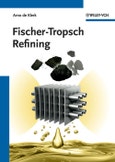The book covers the production and refining of Fischer-Tropsch syncrude to fuels and chemicals systematically and comprehensively, presenting a wealth of new knowledge and material. As such, it deals extensively with aspects of engineering, chemistry and catalysis. This handbook and ready reference adopts a fundamental approach, looking at the molecules and their transformation from feed to product. Numerous examples illustrate the possibilities and limitations of Fischer-Tropsch syncrude as feesdstock.
Of great interest to everyone interested in refining - not just Fischer-Tropsch specialists.
From the Contents:
- Fischer-Tropsch Facilities and Refineries at a Glance
- Production of Fischer-Tropsch Syncrude
- Industrial Fischer-Tropsch Facilities
- Synthetic Transportation Fuels
- Refining Technology
- Refinery Design
Table of Contents
PrefacePART I: Introduction
FISCHER-TROPSCH FACILITIES AT A GLANCE
Introduction
Feed-to-Syngas Conversion
Syngas-to-Syncrude Conversion
Syncrude-to-Product Conversion
Indirect Liquefaction Economics
REFINING AND REFINERIES AT A GLANCE
Introduction
Conventional Crude Oil
Products from Crude Oil
Evolution of Crude Oil Refineries
PART II: Production of Fischer-Tropsch Syncrude
SYNTHESIS GAS PRODUCTION, CLEANING, AND CONDITIONING
Introduction
Raw Materials
Syngas from Natural Gas
Syngas from Solid Carbon Sources
Syngas Cleaning
Syngas Conditioning
Air Separation Unit
FISCHER-TROPSCH SYNTHESIS
Introduction
Fischer-Tropsch Mechanism
Fischer-Tropsch Product Selectivity
Selectivity Manipulation in Fischer-Tropsch Synthesis
Fischer-Tropsch Catalyst Deactivitation
PART III: Industrial Fischer-Tropsch Facilities
FISCHER-TROPSCH GAS LOOPS
Introduction
Gas Loop Configurations
Syncrude Cooling and Separation
GERMAN FISCHER-TROPSCH FACILITIES
Introduction
Synthesis Gas Production
Fischer-Tropsch Synthesis
Fischer-Tropsch Refining
Discussion of the Refinery Design
AMERICAN HYDROCOL FACILITY
Introduction
Synthesis Gas Production
Fischer-Tropsch Synthesis
Fischer-Tropsch Refining
Discussion of the Refinery Design
SASOL 1 FACILITY
Introduction
Synthesis Gas Production
Fischer-Tropsch Synthesis
Fischer-Tropsch Refining
Evolution of the Sasol 1 Facility
Discussion of the Refinery Design
SASOL 2 AND 3 FACILITIES
Introduction
Synthesis Gas Production
Fischer-Tropsch Synthesis
Fischer-Tropsch Refining
Evolution of Sasol Synfuels
Discussion of the Refinery Design
MOSSGAS FACILITY
Introduction
Synthesis Gas Production
Fischer-Tropsch Synthesis
Fischer-Tropsch Refining
Evolution of the PetroSA Facility
Discussion of the Refinery Design
SHELL MIDDLE DISTILLATE SYNTHESIS (SMDS) FACILITIES
Introduction
Synthesis Gas Production in Bintulu GTL
Fischer-Tropsch Synthesis in Bintulu GTL
Fischer-Tropsch Refining in Bintulu GTL
Pearl GTL Facility
Discussion of the Refinery Design
ORYX AND ESCRAVOS GAS-TO-LIQUIDS FACILITIES
Introduction
Synthesis Gas Production in Oryx GTL
Fischer-Tropsch Synthesis in Oryx GTL
Fischer-Tropsch Refining in Oryx GTL
Discussion of the Refinery Design
PART IV: Synthetic Transportation Fuels
MOTOR-GASOLINE
Introduction
Motor-Gasoline Specifications
Motor-Gasoline Properties
Aviation Gasoline
Future Motor-Gasoline Specification Changes
JET FUEL
Introduction
Jet Fuel Specifications
Jet Fuel Properties
Future Jet Fuel Specification Changes
DIESEL FUEL
Introduction
Diesel Fuel Specifications
Diesel Fuel Properties
Diesel Fuel Additives That Affect Refinery Design
Future Diesel Fuel Specification Changes
PART V: Refining Technology
REFINING TECHNOLOGY SELECTION
Introduction
Hydrotreating
Addition and Removal of Oxygen
Alkene Conversion
Alkane Conversion
Residue Conversion
DEHYDRATION, ETHERIFICATION, AND HYDRATION
Introduction
Dehydration
Etherification
Hydration
ISOMERIZATION
Introduction
Reaction Chemistry
Skeletal Isomerization
Hydroisomerization
OLIGOMERIZATION
Introduction
Reaction Chemistry
Catalysis
Syncrude Process Technology
AROMATIC ALKYLATION
Introduction
Reaction Chemistry
Catalysis
Syncrude Process Technology
CRACKING
Introduction
Reaction Chemistry
Thermal Cracking
Catalytic Cracking
Hydrocracking
REFORMING AND AROMATIZATION
Introduction
Thermal Naphtha Reforming
Conventional Catalytic Naphtha Reforming
Monofunctional Nonacidic Pt/L-Zeolite Naphtha Reforming
Aromatization
CHEMICAL TECHNOLOGIES
Introduction
Production of n-1-Aleknes (Linear Alpha-Olefins)
Autoxidation
PART VI: Refinery Design
PRINCIPLES OF REFINERY DESIGN
Introduction
Refinery Design Concepts
Conceptual Refinery Design
Real-World Refinery Design
MOTOR-GASOLINE REFINING
Introduction
Gap Analysis for Syncrude to Motor-Gasoline
Decisions Affecting Motor-Gasoline Refining
Motor-Gasoline Refining from HTFT Syncrude
Motor-Gasoline Refining from LTFT Syncrude
JET FUEL REFINING
Introduction
Gap Analysis for Syncrude to Jet Fuel
Decisions Affecting Jet Fuel Refining
Jet Fuel Refining from HTFT Syncrude
Jet Fuel Refining from LTFT Syncrude
DIESEL FUEL REFINING
Introduction
Gap Analysis for Syncrude to Diesel Fuel
Decisions Affecting Diesel Fuel Refining
Diesel Fuel Refining from HTFT Syncrude
Diesel Fuel Refining from LTFT Syncrude
CHEMICALS AND LUBRICANT REFINING
Introduction
Petrochemical and Lubricant Markets
Overview of Chemicals Refining Concepts for Syncrude
Fischer-Tropsch-Based Petrochemical Refining
Fischer-Tropsch-Based Lubricant Base Oil Refining








